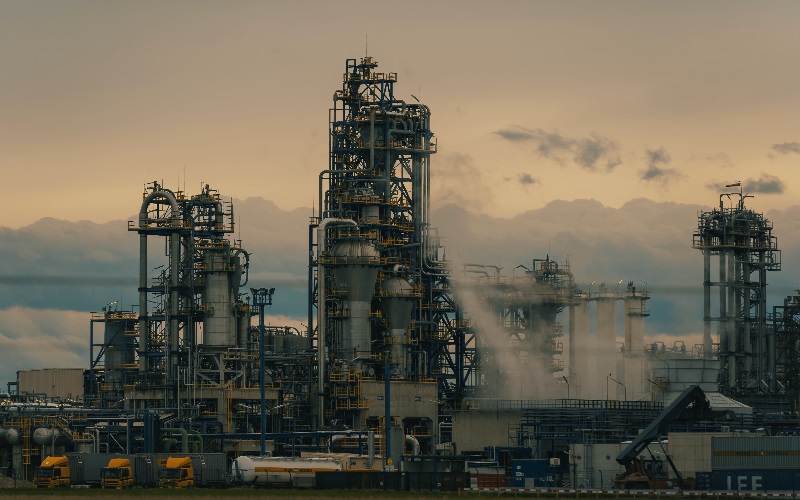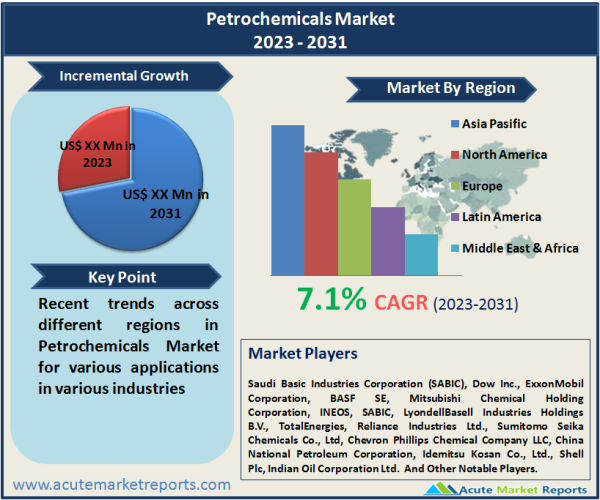
The petrochemicals market is a pivotal sector within the chemical industry, providing the raw materials and building blocks for a vast array of products across multiple industries. The petrochemicals market is expected to grow at a CAGR of 7.1% during the forecast period of 2025 to 2033, driven by the growing demand for petrochemical products, their significant role in the packaging industry, and their widespread use in the automotive sector. However, the environmental impact and sustainability concerns pose a notable restraint. Market segments are influenced by the type of petrochemical products and their applications. Geographically, Asia-Pacific leads in revenue, while the Middle East and Africa regions are expected to experience rapid growth. The competitive landscape is marked by innovation and sustainability initiatives to address the evolving needs of industries and consumers. The future of the petrochemicals market appears promising, with a focus on sustainable practices and ongoing innovation.

Growing Demand for Petrochemical Products
The consistent growth in the demand for petrochemical products remains a pivotal driver for the petrochemicals market. In 2024, the industry experienced significant expansion, propelled by the increasing requirement for petrochemicals across various applications. Petrochemicals, such as ethylene, propylene, and benzene, are the essential building blocks for a wide range of products, including plastics, chemicals, and synthetic materials. The growth of industries such as packaging, automotive, construction, and electronics has driven the demand for these materials. As these industries continue to flourish and expand during the forecast period from 2025 to 2033, the petrochemicals market is poised for sustained growth.
Petrochemicals in the Packaging Industry
The role of petrochemicals in the packaging industry is a major driver for the market. In 2024, the packaging industry witnessed substantial growth, driven by factors such as the surge in e-commerce, the rise in food delivery services, and the growing preference for convenient and sustainable packaging materials. Petrochemicals, particularly plastics like polyethylene and polypropylene, are essential components of packaging materials. They offer versatility, cost-effectiveness, and the ability to create a wide range of packaging solutions, from food containers to protective packaging. The increasing demand for sustainable and recyclable packaging materials has further spurred innovation in the petrochemical industry. This trend is expected to continue throughout the forecast period, leading to robust demand for petrochemical products.
Expanding Petrochemical Use in the Automotive Sector
The utilization of petrochemicals in the automotive sector is another key driver for the market. In 2024, the automotive industry experienced a notable transformation with the increased use of lightweight materials and advanced components to enhance fuel efficiency and reduce emissions. Petrochemicals, including plastics and synthetic rubber, are crucial in the manufacturing of automotive components such as interior materials, engine parts, tires, and lightweight composites. Additionally, the transition to electric vehicles relies heavily on petrochemical products for battery components and lightweight materials. As the automotive industry continues to evolve and adapt to changing consumer preferences during the forecast period from 2025 to 2033, petrochemicals are expected to remain indispensable in automotive manufacturing.
The growing environmental impact and sustainability concerns
One of the principal restraints for the petrochemicals market is the growing environmental impact and sustainability concerns. In 2024, there was an increased awareness of the environmental challenges linked to petrochemical production and usage. Concerns include carbon emissions, plastic waste, and potential hazardous chemical releases. These concerns have triggered regulatory changes and consumer preferences for sustainable and eco-friendly products. While the petrochemical industry has made strides in improving sustainability, these challenges remain a significant restraint. Industry stakeholders must prioritize sustainable practices, including recycling and circular economy initiatives, to address these concerns throughout the forecast period from 2025 to 2033.
Market Segmentation by Product: Ethylene Dominates the Market
The petrochemicals market can be segmented by product into Ethylene, Propylene, Butadiene, Benzene, Xylene, Toluene, and Methanol. In 2024, Ethylene led in both highest revenue and highest compound annual growth rate (CAGR) due to its versatile applications in the production of plastics, chemicals, and synthetic materials. As industries like packaging and automotive expand, the demand for ethylene is expected to remain high during the forecast period (2025-2033).
Market Segmentation by Application: Packaging Dominates the Market
The market can also be segmented by application into Packaging, Automotive, Construction, Electronics, Textiles, Agriculture, Medical, and Others. In 2024, Packaging contributed the highest revenue, given its extensive use of petrochemical-based materials. However, during the forecast period (2025-2033), Electronics is projected to exhibit the highest CAGR. This shift can be attributed to the ever-growing demand for electronic devices and the significant role of petrochemicals in the manufacturing of electronic components.
APAC Remains the Global Leader
Geographically, the petrochemicals market exhibits regional variations. In 2024, Asia-Pacific dominated in terms of revenue due to its extensive industrial activities, with countries like China and India playing pivotal roles. However, the Middle East and Africa region are anticipated to experience the highest CAGR during the forecast period. This growth is driven by substantial investments in petrochemical infrastructure and its strategic position as a global petrochemical production hub. North America and Europe also continue to be significant players in the global petrochemical industry.
Investment in R&D to Enhance Market Presence Among Competitors
The petrochemicals market is highly competitive, with key players such as Saudi Basic Industries Corporation (SABIC), Dow Inc., ExxonMobil Corporation, BASF SE, Mitsubishi Chemical Holding Corporation, INEOS, SABIC, LyondellBasell Industries Holdings B.V., TotalEnergies, Reliance Industries Ltd., Sumitomo Seika Chemicals Co., Ltd, Chevron Phillips Chemical Company LLC, China National Petroleum Corporation, Idemitsu Kosan Co., Ltd., Shell Plc, Indian Oil Corporation Ltd. These companies are committed to the production and supply of petrochemical products and are dedicated to innovation, sustainability, and operational efficiency. To maintain a competitive edge, these companies are expected to invest in research and development to create innovative petrochemical products and reduce their environmental footprint. Throughout the forecast period from 2025 to 2033, the market is expected to witness increased competition, sustainability initiatives, and technological advancements.
Historical & Forecast Period
This study report represents analysis of each segment from 2023 to 2033 considering 2024 as the base year. Compounded Annual Growth Rate (CAGR) for each of the respective segments estimated for the forecast period of 2025 to 2033.
The current report comprises of quantitative market estimations for each micro market for every geographical region and qualitative market analysis such as micro and macro environment analysis, market trends, competitive intelligence, segment analysis, porters five force model, top winning strategies, top investment markets, emerging trends and technological analysis, case studies, strategic conclusions and recommendations and other key market insights.
Research Methodology
The complete research study was conducted in three phases, namely: secondary research, primary research, and expert panel review. key data point that enables the estimation of Petrochemicals market are as follows:
Market forecast was performed through proprietary software that analyzes various qualitative and quantitative factors. Growth rate and CAGR were estimated through intensive secondary and primary research. Data triangulation across various data points provides accuracy across various analyzed market segments in the report. Application of both top down and bottom-up approach for validation of market estimation assures logical, methodical and mathematical consistency of the quantitative data.
| ATTRIBUTE | DETAILS |
|---|---|
| Research Period | 2023-2033 |
| Base Year | 2024 |
| Forecast Period | 2025-2033 |
| Historical Year | 2023 |
| Unit | USD Million |
| Segmentation | |
Product
| |
End-Use Industry
| |
Application
| |
Feedstock Type
| |
|
Region Segment (2023-2033; US$ Million)
|
Key questions answered in this report